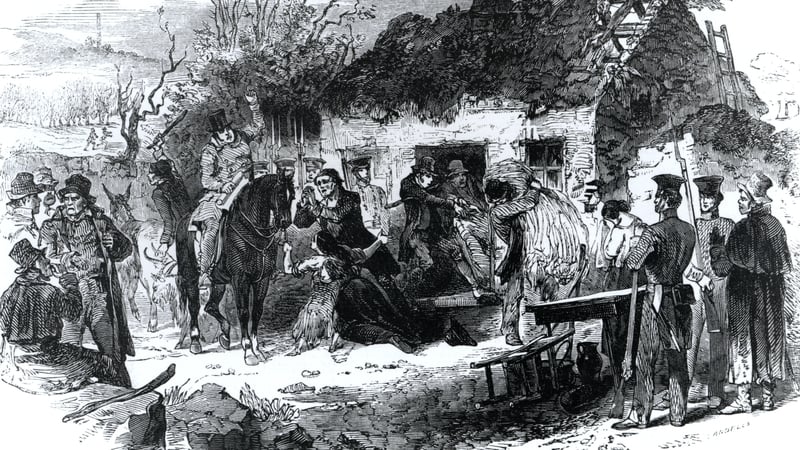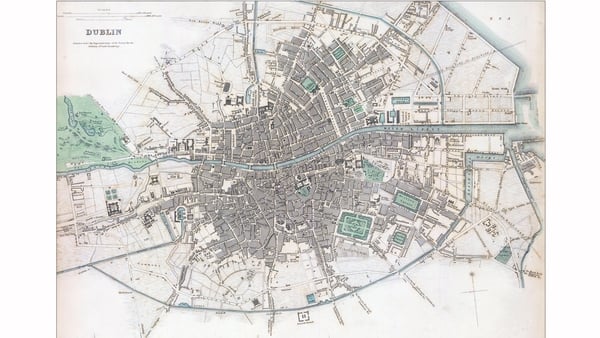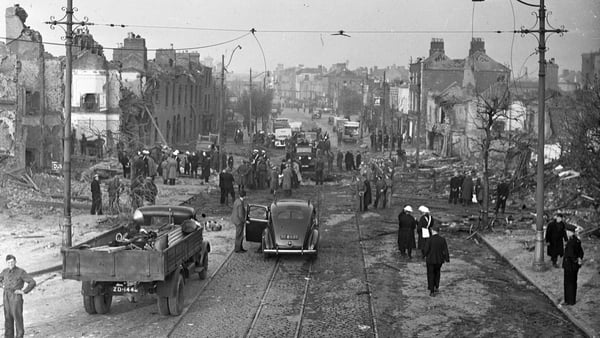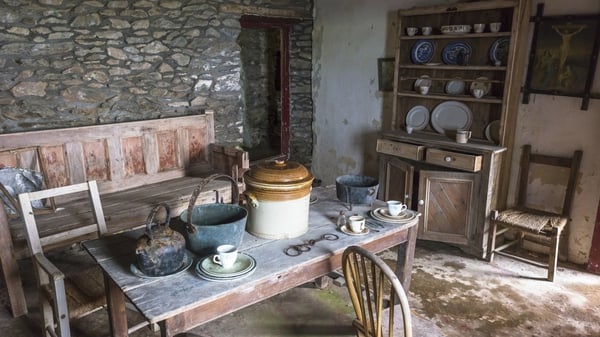Analysis: these reviled figures were involved in the evictions of some 250,000 Irish families during the 1840s and 1850s
The Wrecker was a reviled figure in Famine Ireland and the role they played in evictions was long remembered in many communities. Often referred to as the ‘hut tumbler’ or ‘leveller’, the Wrecker was involved in the levelling of houses which resulted in an estimated 250,000 families losing their homes during the Great Famine.
Undoubtedly, the numbers who were cleared during the 1840s would have been far higher had it not been for the government legislation which did bring some security for tenants. But land agents well versed on the limitations of legislation frequently used intimidating tactics to coerce tenants into paying their rent. So-called rent 'warners' and ‘watchers’ were employed to keep an eye on those who might carry away crops or bring animals to the market. Indeed, on the eve of the Famine one Tipperary landlord went as far as having ‘a dozen crowbars made in the forge’ in an effort to frighten the tenantry into paying their rent.
We need your consent to load this comcast-player contentWe use comcast-player to manage extra content that can set cookies on your device and collect data about your activity. Please review their details and accept them to load the content.Manage Preferences
From RTÉ History, Dr Ciarán Reilly on how endemic poverty devastated Famine Ireland
Many land agents favoured seizing livestock and crops as a means of forcing the payment of rent and arrears, before proceeding to the courts if that failed. Very often, tenants pleaded with the agent or his bailiff and procured the money at the last minute to pay arrears and thus some were allowed to remain as caretakers. Those who were given no further indulgence were duly evicted; the quenching of the fire in the hearth a symbolic moment in the final process of eviction.
No part of the country was immune from eviction. In counties such as Wexford and Kilkenny, where landlords and their agents were widely praised in the early stages of the Famine for their benevolence, it was soon lamented that they turned their attention to eviction. However, it was in counties such as Mayo, Galway, Clare, Limerick, Kerry and Tipperary where the force of eviction was highest; the latter earning the sobriquet ‘Bloody Tipperary’.
While the memory of eviction lingered in many parts of the country, evictions were largely forgotten in other places. In Roscommon, for example, the eviction of 270 people at Frenchpark by the landlord William Murphy of Smithfield in Dublin were deemed unimportant in local social memory, as was the levelling of 57 houses (which forced the removal of 128 people) at Lung, near Boyle in 1848.

What was perhaps most remarkable about the Famine evictions was the lack of resistance which was offered by the evictees or the local community. In Athlone, for example, the Freeman's Journal queried how the people had remained ‘remarkably quiet and exemplary’ when faced with eviction. There were only two people present as the evicted pulled down the houses themselves at an eviction on the D'Estere estate at Redgate, Co Limerick. Likewise, the presence of the military when 40 people were evicted from the Coote estate at Ballingarry in Co Limerick was deemed ‘most needless’.
Much of this apparent apathy stemmed from the frequency of eviction which was an almost daily occurrence. However, eviction did fuel a number of assassinations and attempts. In Offaly the murder of the agent Robert Pyke near Ferbane in 1850 followed the removal of several families, as did that of Thomas Douglas Bateson in Co Monaghan the following year.
‘Of Monsters and ogres’
In the decades that followed the Famine, much of the antipathy towards the landed class stemmed from the actions of their bailiffs and hired help who had carried out evictions. Fuelling much of this was the part which the local community played in the eviction process. During what came to be known as the 'sack of Toomevara' in Tipperary in 1849, it was members of the local community who were hired to do the dirty work. Likewise, in Ballycumber, Co Offaly, tenants were forced to pull down their neighbour’s houses and offered a trifling compensation for doing so.
We need your consent to load this rte-player contentWe use rte-player to manage extra content that can set cookies on your device and collect data about your activity. Please review their details and accept them to load the content.Manage Preferences
From RTÉ Radio 1's Morning Ireland, should descendants of Charles Trevelyan be asked to pay reparations?
There was little remorse or charity on their part as they tormented those who were gripped with fever and hunger. Such was the zealousness of the ‘levellers’ that whole townlands could be razzed in an afternoon’s work. In Clondoogan, Co Meath in 1848, it took only a few hours to level 17 houses and clear a whole townland. In Doonbeg, Co Clare, ‘not a stone upon a stone’ was left after the razzing of 40 houses in early September 1849. These clearances altered the landscape irrevocably, such as at Drimnagh, Co Roscommon in 1847 when 210 people were removed from the Barton estate.
Wreckers carried out their duties with particular vengeance. At one eviction in Offaly, the bailiffs were said to have been armed with hatchets and pitchforks ensuring that no remnants of the houses were left visible. During the course of an eviction from the Beamish estate at Clonakilty, Co Cork in September 1847, where 95 people were removed, it was claimed that one poor woman was ‘being buried to death amongst the ruins from which she had not the strength to drag her weakened limbs’.
There was no shortage of lamentable stories. At an eviction on the Ashbrook estate in Johnstown, Co Kilkenny, a young boy was reported to have been struck by lightning and exposed to the elements during a thunderstorm. In Offaly, a Catholic priest reported that he had seen a ‘wretched mother, with her three children, actually lying in the snow’ while their house was being levelled. At Lord Clonmel's estate in Tipperary, it was claimed that ‘nothing could be more distressing than to hear the clanking of the crowbars demolishing the cabins, which were mingled with the most pitiful and heartrending shrieks of women and children’.
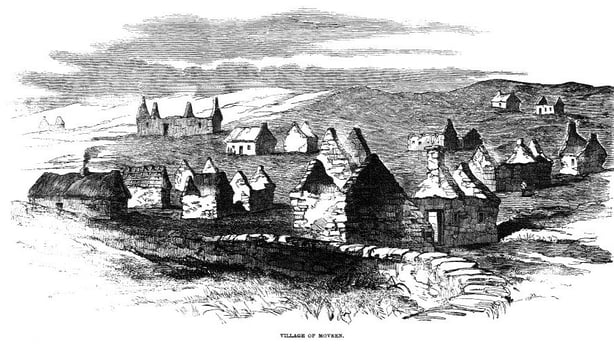
Unsurprisingly, the Wrecker and hut levellers were the targets of much of the violence that followed. These brigades of wreckers were hated figures in their local communities, described as ‘monsters’ and ‘ogres’ content with ‘carrying out the devils work’. Others referred to them as ‘burly ruffians’ who went about their duties with little remorse for the people.
There were appalling instances of cruelty and malevolence. In Meelick, Co Galway, a man named Gallagher returning from paying the rent to find that his house had been levelled while his children were inside. A young woman named Biddy McLaughlin was assaulted by bailiffs during the course of an eviction near Buncrana, Co Donegal and was subsequently fined by the local petty session court for her conduct.
The sheer scale of eviction, particularly in the south and west of the country, prompted newspapers to employ special correspondents who visited the scene of the clearances. Among the reporters in the field was James MacCarthy, proprietor of the Limerick Examiner who led the way in this regard undertaking a ‘pilgrimage, amid scenes of havoc and despair’.
We need your consent to load this YouTube contentWe use YouTube to manage extra content that can set cookies on your device and collect data about your activity. Please review their details and accept them to load the content.Manage Preferences
Trailer for Wrecker, a new short film based on a father and daughter's struggle during the Famine in Ireland
MacCarthy had no shortage of material to report on, particularly in counties such as Clare and Tipperary but it was a perilous task. On several occasions, MacCarthy was 'assailed and insulted in the discharge of his duty by some of the disgruntled wretches who were employed in levelling the houses of the evicted tenants'. It was these actions and more that ensured that the ‘Wrecker’ would be long remembered in many communities.
A new short film to be screened at the Cork International Film Festival this month recalls some of the worst injustices inflicted on the poor and starving during Ireland’s Great Famine. Written by Aoife Bradshaw, directed by Martina McGlynn and produced by Garret Daly of Mixed Bag Media, Wrecker tells the story of a father and daughter’s struggle during the Famine in Ireland. Faced with the grim reality of eviction and starvation, the young girl learns just how far her father is willing to go to survive.
The views expressed here are those of the author and do not represent or reflect the views of RTÉ
